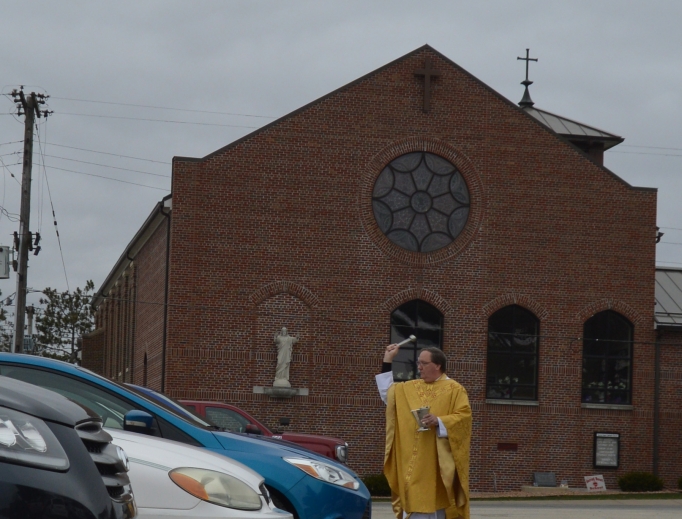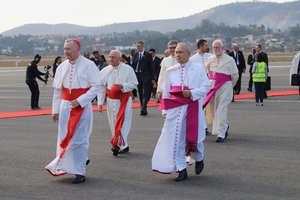Easter Arrives on Schedule, Despite Coronavirus Pandemic
Despite curtailed liturgies, priests found plenty to celebrate during Holy Week and the Triduum.

The liturgical celebrations of Holy Week and Easter Sunday 2020 went largely unattended around the world because of the restrictions imposed to stem the spread of coronavirus (COVID-19). Yet, as unprecedented as this year’s celebrations were, the threat of coronavirus did not eclipse the greatest unprecedented event in history — Jesus Christ’s passion, death and resurrection — re-presented in liturgical celebrations around the globe.
Many — if not most — priests and bishops may not have had their parishioners in their pews for Holy Week and Easter, but they still were joined by the universal Church in celebrating the greatest liturgical events of the year. With some help from the Vatican, which issued guidelines on March 19, March 25 and April 1 to celebrate this year’s Holy Week and Easter liturgies — the faithful “attended” the Triduum (Holy Thursday’s Mass of thanksgiving, which commemorates the institution of the Eucharist, Good Friday, and Holy Saturday), culminating in the “mother of all vigils,” as St. Augustine called it, via livestream on the internet and television.
Ad Hoc Celebrations
Part of the challenge for pastors in celebrating the rich array of liturgical rites occurring during Holy Week and Easter Sunday has been to figure out exactly how to celebrate these rites, since many of them — such as the adoration of the cross on Good Friday or the blessing of the holy fire at the Easter vigil — presume the presence of the faithful.
Christopher Carstens, editor of the liturgical journal Adoremus Bulletin and director of the Office of Divine Worship for the Diocese of La Crosse, Wisconsin, consulted in the days leading up to Holy Week and Easter with other diocesan liturgy offices and priests around the country as well as with priests in his own diocese about how best to approach this year’s celebrations.
“Most dioceses — ours and others — began making firm recommendations, especially for Holy Week, during the week of March 16-20,” he told the Register.
According to Carstens, the priests he’d spoken to found particular challenges in planning their celebration of Holy Week.
“Priests are doing their best to try to reconcile the absence of people and this year’s revised liturgical norms, but to still celebrate in a way that is beautiful and that glorifies God,” he said. “How, for example, is Palm Sunday celebrated without palms? How does the local Church adore the cross on Good Friday when the people cannot? How does a priest mark the passage of the Lucernarium [evening service of light] from darkness to light during the Easter vigil when the procession is eliminated?”
As Carstens noted, some elements of the liturgy were left to the discretion of particular pastors in their parishes.
“The revised liturgical norms from the Holy See are, as they must be, very broad,” Carstens said. “Yet even on the diocesan level there may be a number of legitimate variations this year. And this lack of precise direction demands that the local pastor determine the best way to serve his people by the liturgy and glorify God at the same time.”
These considerations come as Las Cruces, New Mexico, becomes first U.S. diocese to resume public Masses amid coronavirus.
User’s Guide
As editor of Adoremus, Carstens responded to some of these challenges in a series of articles written by Msgr. Marc Caron, a priest of the Diocese of Portland, Maine, and professor of liturgy as St. John’s Seminary in Brighton, Massachusetts, including suggestions on how best to celebrate Holy Thursday and Good Friday of the Triduum, the Easter vigil and Easter Sunday.
Speaking to the Register on Holy Wednesday, Msgr. Caron said that pastors could follow some basic liturgical principles to help them revise their celebrations accordingly.
“Regarding the principles in play,” Msgr. Caron said, “I think it is always best to begin with the liturgical books themselves. What are the books asking me, as a celebrant, to do? Can I read the directions included in the liturgical books with new eyes so that I don’t read into them simply my past experience but what is demanded of me by the Church?”
“I also think it is important to scale the celebrations properly. This is related to acting in such a way as to acknowledge the truth of the situation. In other words, it will make the celebration appear ridiculous if I am acting as if there are 500 people in the church. That means being humble enough to scale down the celebration so that it feels proportionate to those attending and to those following on the media.”
Holy Father Shows the Way
Msgr. Caron cited Pope Francis’s celebration of Palm Sunday Mass at St. Peter’s in Rome “as a very fine example of such a scaling down, completely within the existing rubrics of the rite itself.”
According to Vatican News, Palm Sunday 2020 was the first time in the Church’s history that the pope celebrated this Mass without a congregation. The Mass did include the use of incense “at the usual points of Mass,” Msgr. Caron said, and included the ministry of a deacon. There was also a choir — although smaller than usual, with only eight persons participating. The reading of the Passion included three readers, as in most typical celebrations of Palm Sunday Mass, he added, but “they happened to be priests rather than deacons — and they doubled as servers during the Mass.”
“There were also a number of other simplifications to the Palm Sunday Mass,” Msgr. Caron noted. “Mass did not begin with an outdoor procession. It began inside the basilica before the main altar, as a kind of solemn entrance. Normally that is done at the door of the church or just outside the door. In the case of St. Peter’s, beginning at the door would be impractical” because of the absence of a congregation.
“Some members of the lay faithful are meant to be part of the solemn procession,” Msgr. Caron told the Register. “In this case, only the clergy acting as servers accompanied the Holy Father.”
For the Mass itself, he said, a number of small but significant differences demonstrated that this was no ordinary Palm Sunday Mass.
“The deacon was seated at a distance from the Holy Father rather than next to him, so as to avoid being too close to him,” he said. “The Passion was read by three priests rather than sung, and the missal rested on a stand in front of the Holy Father rather than being held by a server — which would place that server too close to the Holy Father.”
Creative Liturgy
While many of the faithful watched these liturgical celebrations remotely by livestreaming, TV broadcasts and other media, some pastors around the country found more immediate ways to bring the sacrament to their parishioners, including drive-in Mass, to celebrate Mass with their flocks even as they maintained proper social distancing.
Father Michael Klos is pastor of three parishes in the Diocese of La Crosse — Sacred Heart, Cashton; St. Mary’s, St. Mary’s Ridge; and St. Augustine’s, Norwalk, and he serves about 500 families among these three parishes. He began offering drive-in Masses after he heard another priest in the diocese was doing the same thing.
“It was actually the parishioners who wanted to have Mass in this way,” he told the Register. “So I told them I would contact this other priest; and, after talking with him, I thought it an appropriate way to make Mass and the Eucharist available to the parishes on Palm Sunday.”
With the aid of a radio transmitter, which parishioners attending the drive-in Mass can tune their car radios to, Father Klos celebrates Mass within a makeshift shelter, constructed of two-by-fours and plastic sheeting, upon a trailer previously used to haul antique tractors.
The drive-in Masses are held in the Sacred Heart parking lot, set against the hills and bluffs of southwest Wisconsin’s dairy country. According to Father Klos, an average of 60 cars filled up the parking lot for Palm Sunday and Holy Thursday Masses. He also celebrated Good Friday services and the Easter vigil in the parking lot.
On Easter Sunday, he had two Masses — at 8 and 10am, which drew similar numbers.

Both practically and as a matter of maintaining social distancing, Father Klos does not distribute Communion during the drive-in Masses, but it is important that his parishioners have access to the sacrament, he said.
“As Catholics, we believe that the Eucharist is not a symbol or a remembrance, but the Real Presence of Christ,” he told the Register after the 8am Easter Mass. “There’s nothing wrong with watching Mass on TV, but it’s not the same as being present before the Eucharist itself.”
Be Not Afraid!
During his homily for the 8am Mass, Father Klos said that because of Christ’s resurrection, even in this time of pandemic, Christians should take courage.
“As we have gone through this holy Triduum, in this pandemic of the coronavirus, we find ourselves prepared and, I hope, with hearts open to understand a particularly important lesson, a lesson taught to us over and over again,” he said, adding, “That lesson is: Be not afraid! Be not afraid of death! Be not afraid of the powers of this world! Be not afraid of the coronavirus!”
Christ’s resurrection, Father Klos said in his homily, puts the pandemic in the proper Christian perspective.
“So, my brothers and sisters,” he concluded, “on this Easter Sunday in the midst of this pandemic, we are called to hope and to be not afraid. Yes, take the proper precautions that are necessary. Be prudent. Be wise. But also be confident in the love of God. Recognize that as lovely and wonderful and important as this life is, it is not God. It is not the end, but only … the beginning.”
Register correspondent Joseph O’Brien writes from Soldiers Grove, Wisconsin.
- Keywords:
- coronavirus
- easter
- holy week
- joseph o’brien
- liturgy
- triduum
















